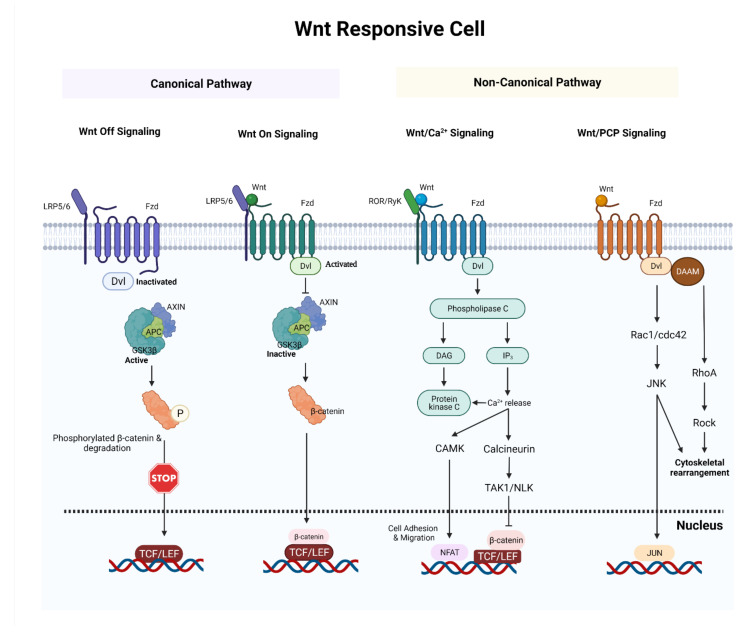Figure 1.
A synopsis of the canonical and noncanonical Wnt signaling pathways. In canonical Wnt off signaling, a combination of AXIN and APC allows GSK3β to phosphorylate β-catenin and target it for proteolysis. In canonical Wnt on signaling, Wnt ligands bind and activate Fzd receptor and activated Fzd receptor recruits Dvl protein and AXIN. This blocks the formation of an AXIN–APC complex and inhibits GSK3β. As a result, β-catenin avoids destruction and accumulates in the nucleus. In non-canonical Wnt/Ca2+ signaling, the interaction of Wnt/Fzd with ROR/Ryk co-receptor leads to the formation of IP3 and DAG. DAG activates PKC. IP3 triggers ER Ca2+ release which stimulates calcineurin and CAMKⅡ. This activates TAK1/NLK and NFAT. Activated TAK1/NLK can inhibit TCF/β-catenin signaling and NFAT can regulate cell adhesion and migration. In non-canonical Wnt/PCP signaling, the interaction of Wnt/Fzd leads to the recruitment of Dvl, which utilizes its domains (PDZ and DIX) to produce a complex with DAAM. DAAM then stimulates RhoA. Activated RhoA can activate Rock. Dvl can also produce a complex with Rac1 to activate JNK. Abbreviations: APC, adenomatous polyposis coli; GSK3β, glycogen synthase kinase 3β; LRP5/6, low-density lipoprotein receptor-related protein 5/6; TCF/LEF, T-cell factor/lymphoid enhancer-binding factor; IP3, inositol trisphosphate; DAG, diacylglycerol; CAMKⅡ, calcium/calmodulin-dependent protein kinase II; TAK1, transforming growth factor beta-activated kinase 1; NLK, nemo like kinase; NFAT, nuclear factor of activated T-Cells; Dvl; disheveled; Fzd, frizzled; DAAM, disheveled-associated activator of morphogenesis, ROCK, Rho-associated kinase. (Created with https://biorender.com/, accessed on 18 December 2021).

